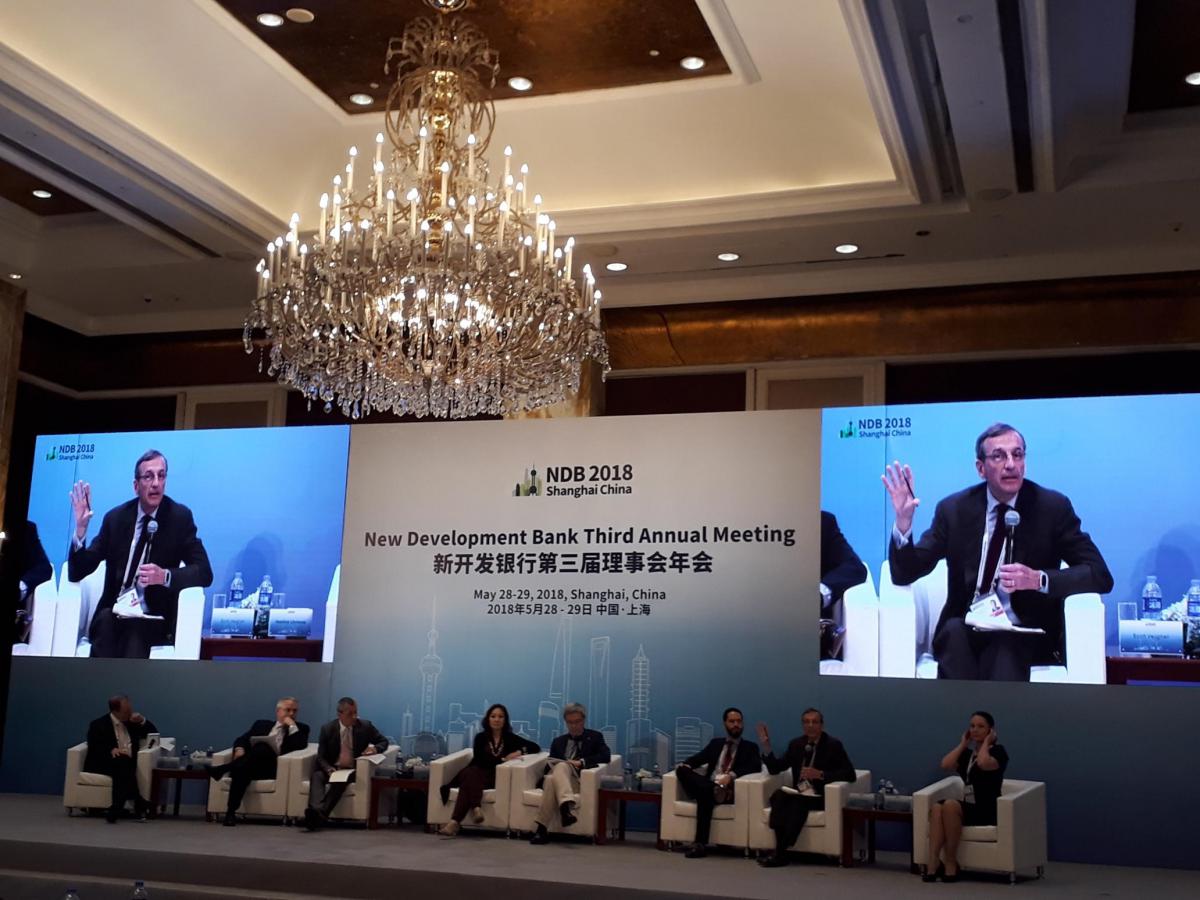IISD Contributes to the Annual Meeting of the New Development Bank
IISD applauds the New Development Bank for setting out a clear target whereby two thirds of its portfolio will advance sustainable infrastructure as well as their strategic focus on clean energy, irrigation and water resource management.
The New Development Bank (NDB), located in Shanghai, has an important opportunity to advance sustainable development through its project lending and related knowledge functions.
One aspect of this broad challenge is sustainable infrastructure. The decisions countries and companies make today in infrastructure investments will lock in development choices for the next 30–50 years. IISD applauds the NDB for setting out a clear target whereby two thirds of its portfolio will advance sustainable infrastructure, as well as their strategic focus on clean energy, irrigation and water resource management. These commitments are particularly timely in the context of the Ministry of Ecology and the Environment's Green Belt and Road Coalition, of which IISD is pleased to be a member.
The Sustainable Development Goals (SDG Knowledge Hub) underscore the scope and interconnected nature of sustainable development.
A pressing priority within the Sustainable Development Goals (SDGs) of urgent relevance to infrastructure is climate change. Every country, community and economic sector on the planet is facing growing climate change risks. Estimates suggest that climate risk in 300 of the world’s major cities today stands at USD 1.5 trillion, with projected damages related to extreme weather events like severe flooding, coastal sea-surge damages, increased forest fires and other impacts. Recently, NASA warned of a looming water crisis in 19 hotspots where freshwater depletion is likely to resemble the current crisis facing Cape Town.
It is important that multilateral development banks (MDBs) demonstrate that climate resilience is a strategic, financing and project priority for infrastructure. We are already seeing a growing number of infrastructure projects that include climate resilience, such as those that anticipate the increased frequency of 100-year extreme weather events coming with far greater frequency. Country-based climate adaptation work now has the benefit of drawing from a large body of evidence.

IISD colleagues have examined how development and adaptation are moving more closely in sync in the past decade. IISD serves as the secretariat of the 100-country National Adaptation Plan Global Network, which shares practical examples of climate adaptation planning, project financing and actions.
The second challenge for green infrastructure is making sure planning, design and building are part of the solution to the Paris climate agreement. Next week, Canada will announce new funding for infrastructure and, with it, a climate lens for every project over CAD 10 million to determine both the carbon footprint and the climate resilience of infrastructure projects.
Public finance and MDBs need to be leaders in advancing infrastructure that accelerates a shift to low-carbon energy systems like renewable energy and in integrating best-in-the class energy-efficiency standards for buildings. We need to plan today for mid-century infrastructure based on the notion of a shared economy with public transport.
There is growing attention to low-carbon building materials like cement and steel. Recently, Apple promised to source low-carbon aluminum throughout its global supply chain, and architects, engineers and city planners have displayed encouraging attention to substitute building materials. There are a number of 8–10-storey wooden buildings already completed and many more under construction. In addition, Tokyo has announced plans for a 70-storey building made of 90 per cent wood-based materials.
Another way of looking at this is from a natural or green infrastructure lens. Natural Infrastructure is a new asset class for sustainable development and climate resilience; its decentralization takes advantage of fourth industrial revolution technology and mitigates social marginalization. For example, scientific literature is now showing that protecting and restoring wetlands in some flood-prone agricultural areas is more effective in specific cases than building complex dams and dikes.
Channelling institutional finance into natural infrastructure has the potential to deliver large-scale sustainable development benefits.
Finally, the nature of sustainable infrastructure demands an integrated, dynamic approach that includes such variables as climate externalities, social priorities like public health, labour markets and policy risk, as well as how to include these variables in infrastructure project financing. That has been the focus of IISD’s sustainable infrastructure modelling work.
IISD is developing guidance material on infrastructure risk mitigation instruments, including local currency risk mitigation. We aim to raise awareness on how sustainable infrastructure projects can be planned to make better use of de-risking instruments and seek platforms upon which to share green infrastructure projects in real time, as well as a facility to help countries prepare for green infrastructure projects.
You might also be interested in
Unlocking Supply Chains for Localizing Electric Vehicle Battery Production in India
This study aims to highlight the key supply chain barriers in localizing electric vehicle (EV) battery cell manufacturing in India. It summarizes consultations with 12 companies, as well as experts and policy-makers, to determine the crucial challenges and opportunities in localizing battery manufacturing in India.
Sustainable Asset Valuation of the Benefits of Nature-Based Infrastructure in Kenya
In this integrated cost-benefit analysis, the Nature-Based Infrastructure Global Resource Centre analyzes the potential of nature-based infrastructure (NBI) to combat water scarcity and enhance sustainable agriculture in Kenya.
Sustainable Asset Valuation (SAVi) of Nature-Based Infrastructure in Eswatini
In this integrated cost-benefit analysis, the Nature-Based Infrastructure Global Resource Centre analyzes the potential of nature-based infrastructure (NBI) to enhance agricultural productivity and hazard protection in Eswatini.
IISD Annual Report 2023–2024
While IISD's reputation as a convenor, a trusted thought leader, and a go-to source on key issues within the sustainable development field is stronger than ever, the work happening outside the spotlight is just as valuable.
